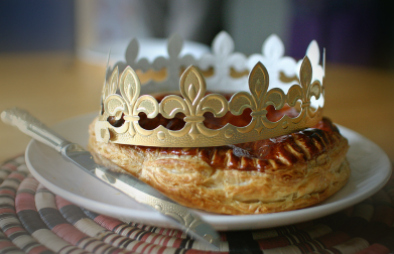A Moment of Epiphany
Case Study


Our son came home from school with the fève yesterday. He always does.
Every January when we are packing away the Christmas decorations and Epiphany rolls around, Sebastian starts talking about the galette des rois and the fève, or bean, he is certain he will find inside. As French holiday traditions go, it’s one of my favorites. The galette, a pastry usually filled with frangipane, is supposed to contain one bean. Whoever gets the bean is “king” for the day. Sebastian, a six-year-old born to the purple if ever there was one, comes home with the bean and a little paper crown every year.
Of course the bean stopped being a bean more than a century ago, and was replaced by tiny ceramic figurines. In the old days they were little nativity figures, so whoever got to be king would come home with a miniature angel or Baby Jesus to put among other childhood keepsakes. Modernity being what it is, these days your child is far more likely to turn up a character from the latest Pixar film than a Biblical figure. I have to admit, that sharp little piece of ceramic lurking in my son’s dessert seems alarmingly easier to swallow than the corporate crassness of replacing Mary and Joseph with Asterix and Obelix. But the look on Sebastian’s face when he puts on his paper crown makes the risk seem worth it. He hasn’t broken a tooth yet.
Now, I’m not one to doubt my little boy’s suitability to be king every year, but I couldn’t help becoming a little suspicious. At school they go through several of those pies every January, and Sebastian’s figurine collection is starting to pose storage problems. “I think there was more than one fève,” he ventured cautiously, interspersing his accented English with perfectly pronounced French words. “Actually, lots of kids got one.” This didn’t seem to diminish the excitement in the slightest.
When Sophia commented that the ones we buy at the supermarket have only one figurine, his highness shot us an exasperated look. “No, but Danielle’s dad made the galette for our school lunch. He must have put in lots of fèves.” He looks at his fève proudly – this one is a somewhat sleazy-looking man in a yellow suit, with bits of almond filling still lodged under the ridge of his jacket. “Can I watch some television?”
I’ve never met Danielle’s father – unfortunately chance has dictated that I will always imagine him as a sleazy-looking man in a yellow suit – but he has made my day. Beyond the fact that our son survived yet another encounter with a school-sponsored choking hazard, I love knowing who baked Sebastian’s galette des rois. When I try to imagine a similar thing happening back in the US or in England, I keep running up against images of concerned parents objecting on the basis hygiene laws, legal responsibility, child safety… Offering homemade pies from relatives of school employees – Danielle cooks the school lunches, among other things – seems to my American legal mind like a potential liability issue. Back home, perhaps it would be.
But the French, bless them, just don’t see it that way. It’s not that there is any lack of regulations. On the contrary, the French love them, and French bureaucrats are famous for wielding them with astonishing inflexibility and even a certain sinister pleasure. But, especially out here in the countryside, the law is made to be ignored if it gets in the way of more important values, like food.
This relaxed Gallic approach to rules has its downsides, as anyone who has managed to survive driving in France will appreciate. But in a tiny community like this, it’s priceless. Rules exist to guide behavior because, particularly in a large community, social norms are incapable of doing so. In a community of a few hundred people, however, where everyone knows everyone else (and, let’s be honest, is almost certainly everyone else’s cousin), the rules can be tucked in a drawer, to be pulled out only in time of need. As long as no one complains, there is no problem. No harm, no foul.
This doesn’t work in a community of strangers. Parents, as a general rule, don’t want random strangers feeding pies to their kids. But in a small community, there are no random individuals. Strange ones, perhaps, even a few scary ones. But in a village everyone is accountable to everyone. The cook in the school cantine is also your neighbour. Her husband works at your bank. Her brother-in-law is the cantonnier, the man in charge of local roadworks and other odd jobs around the village. And her father, turns out, is the guy who manages to pack all those figurines into the school’s galettes des rois. It’s all entre nous.
If it all sounds a little inbred and stifling, well, it can be. That guy who nearly got you killed by trying to pass you on a blind curve… before you start exploring fascinating subject of English versus French hand gestures, you may want to think twice about who he might be. Next week he could resurface as the grandson of the charming widow who lives in the farm up the road. He could be the mayor’s younger brother. Whoever he is, he is closer to you than you want him to be, and there’s not a damn thing you can do about.
But this small town interconnectedness is also liberating. Danielle’s father is free to make his galettes for the schoolchildren. It allows Laurent the bus driver to give all the kids on his bus a piece of candy every day in symbolic defiance of his own diabetes (even in defiance of parents’ valiant but futile attempts to control how much candy their kids eat). In an age when, at least in the US, teachers cannot touch their pupils for fear of child abuse allegations, it allows Danielle to give the children hugs when they are down. In short, it paves the way for random acts of kindness.
And it means that Sebastian always gets to be king. This could be a problem…
By Gregory Mose.
To read more of Gregory’s articles about life in the deep Quercy visit his blog
Lead photo credit : galette des rois carousel
Share to: Facebook Twitter LinkedIn Email
More in banking, children, cooking, food, guides, schools, villages
By FrenchEntrée
Leave a reply
Your email address will not be published. Required fields are marked *



